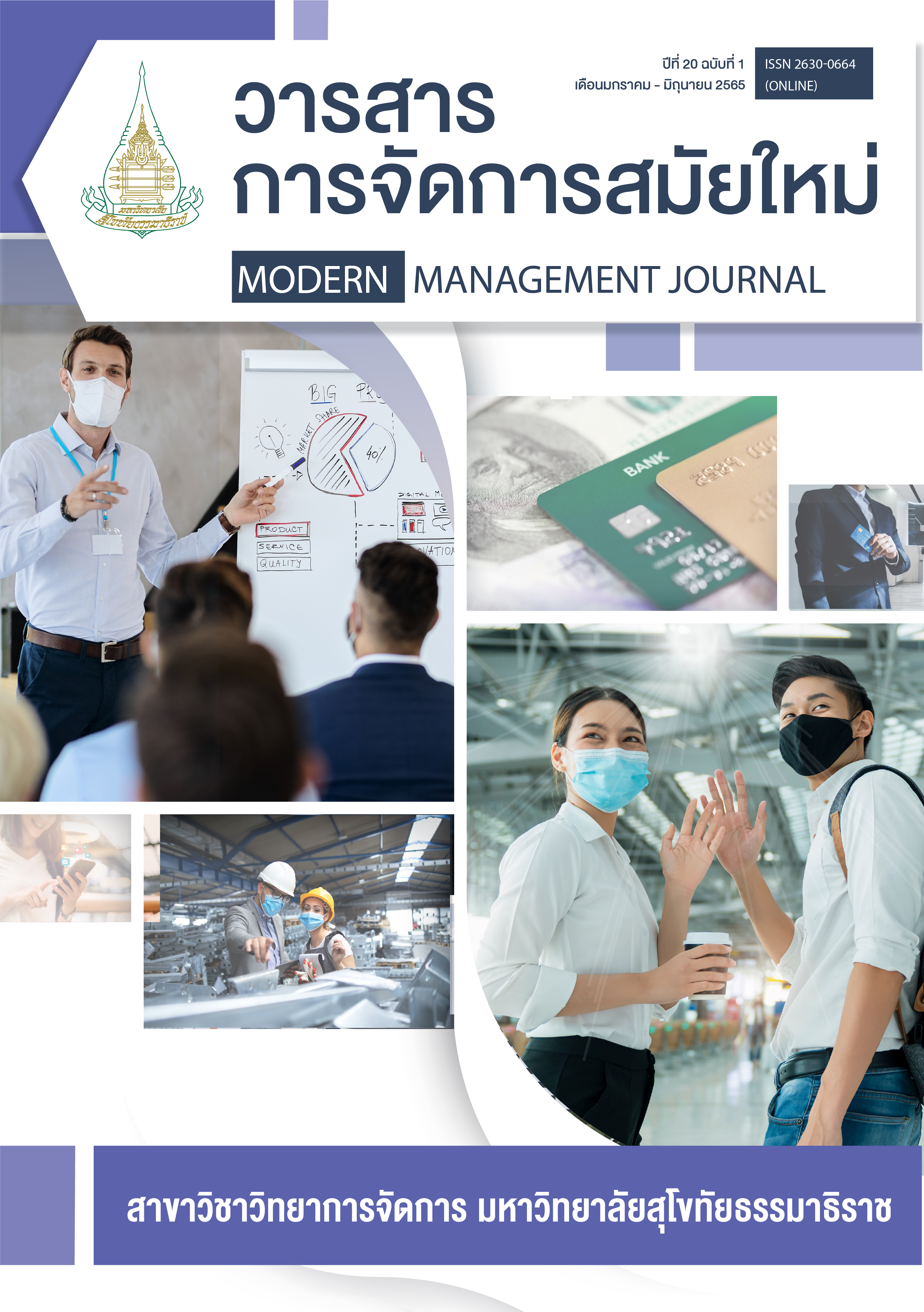Construction Business Performance from Creative Development Value-Based Management and Profitability Assessment
Keywords:
Creativity, Technology Value-Base, Profitability Assessment, Firm’s PerformanceAbstract
บทความนี้มีวัตถุประสงค์เพื่อ 1) ศึกษาระดับการรับรู้ของปัจจัยการพัฒนาความคิดสร้างสรรค์ ความสามารถในการสร้างมูลค่าจากเทคโนโลยี การประเมินความสามารถในการทำกำไร ความสามารถของธุรกิจ การปรับตัวของธุรกิจ และผลกำไรของธุรกิจ ของอุตสาหกรรมการก่อสร้างไทย และ2)ศึกษาอิทธิพลของปัจจัยการจัดการนวัตกรรมในอุตสาหกรรมการก่อสร้างไทยจากการบริหารฐานคุณค่าต่อผลประกอบการธุรกิจ โดยมีกลุ่มตัวอย่างได้แก่โดยการใช้ขนาดตัวอย่าง 200 บริษัทในกลุ่มก่อสร้างไทยขนาดเล็กและกลางในธุรกิจก่อสร้างที่ตั้งในเขตกรุงเทพฯและใช้การวิเคราะห์ข้อมูลด้วยสมการโครงสร้าง (SEM)
ผลการวิจัยพบว่าปัจจัยการพัฒนาความคิดสร้างสรรค์มีอิทธิพลเชิงลบต่อทั้งปัจจัยการจัดการพัฒนาความคิดสร้างสรรค์ และการยอมรับเทคโนโลยี ดังนั้นการจัดการเรื่องการพัฒนาความคิดสร้างสรรค์จึงเป็นประเด็นที่บริษัทเหล่านี้ต้องปรับปรุงด้วยการช่วยพัฒนาร่วมกันกับเครือข่ายธุรกิจเดียวกันเพื่อเป็นการลดต้นทุน และส่งเสริมการนำความคิดสร้างสรรค์มาใช้ในงานก่อสร้าง
References
Adair, J. (2007). Leadership for Innovation: How to Organize Team Creativity and Harvest Ideas. Human Resource Management International Digest, 18(6), 235- 269.
Agarwal, R., Chandrasekaran, S., & Sridhar, M. (2016). Imagining construction’s digital future. Retrieved from https://www.mckinsey.com/business functions/operations/our- insights/imagining-constructions-digital-future#
Aldridge, T., & Audretsch, D. B. (2010). Does policy in fluence the commercialization route? Evidence from National Institutes of Health funded scientists. Research Policy, 39(5), 583-588.
Baucus, M., Norton, W., Baucus, D., & Human, S. (2008). Fostering creativity and innovation Without encouraging unethical behaviour. Journal of Business Ethics, 81, 97-115.
Biedenbacha, T., & Müllerab, R. (2012). Absorptive, innovative and adaptive capabilities and their impact on project and project portfolio performance. International. Journal of Project Management, 30(5), 621-635.
Chang, J. W., Wang, T., Lee, M., Su, C., & Chang, P. (2016). Impact of Using Creative Thinking Skills and Open Data on Programming Design in a Computer-Supported Collaborative Learning Environment. IEEE 16th, International Conference on Advanced Learning Technologies.
Chaudhary, K., & Sharma, M. (2011). Performance of Indian Public Sector Banks and Private Sector Banks: A Comparative Study. International Journal of Innovation, Management and Technology, 2(3), 249-256.
DBD Annual Report, 2561-2564. Department of Business Development. Retrieved June 15 2020 from https://www.dbd.go.th/news_view.php?nid=469413374
Gama, F., & Parida, W. (2017). Systematic Idea Generation and Organizational Capabilities for Front-End Innovation Performance in SMEs. Retrieved from https://innovationmanagement.se/2017/03/16/systematic-idea-generation-and-organizational-capabilities-for-front-end-innovation-performance-in-smes/
Kale, P., Singh, H., & Perlmutter, H. (2000). Learning and protection of proprietary assets in strategic alliances: Building relational capital. Strategic Management Journal, 21 (3), 217-237.
Klimczuk-Kochańska, M. (2017). Importance of Creativity of Employees in Adaptation of Food Companies to Innovative Trends in the World. Human Resources Management and Ergonomics,11(1), 50-64
Loof, H., & Heshmati, A. (2006). On the relationship between innovation and performance: a sensitivity analysis. Economics of Innovation and New Technology, 15(4–5), 317–344.
Nebojša, S., Iraj, H., & Zoran, A. (2018). Creativity, innovations and firm performance in an emerging transition economy. Ekonomski pregled, 69(3), 203-228.
Nickerson, R. S. (1999). Enhancing creativity. In R. J. Sternberg (Ed.), Handbook of creativity, Cambridge University Press., 392-430
Nimalathasan, B. (2009). Profitability of Listed Pharmaceutical Companies in Bangladesh: An Inter & Intra Comparison of Ambee & IBN Sina Companies/Annals of University of Bucharest, Economic and Administrative Series, Nr. 3, 139-148
Porter, M. E. (1980). Competitive Strategy: Techniques for Analyzing Industries and Competitors. New York: Free Press.
Raduan, C. R., Jegak, U., Haslinda, A., & Alimin, I. I. (2009). Management, strategic Management theories and the linkage with organizational competitive advantage from the resource-based view. European Journal of Social Sciences, 11(3), 402-417.
Raza, S. A., Farooq, M. S., & Khan, N. (2011). Firm and Industry Effects on Firm Profitability: An Empirical Analysis of KSE. Forthcoming in: International Research Journal of Finance and Economics. Retrieved from https://mpra.ub.uni- muenchen.de/36797/
Siddiqi, H., & Qureshi, M. (2016). The Impact of Employees’ Creativity on the Performance of the Firm. Research issues in social sciences, 1(1)1-12.
Singer, B. P., Bossink, B. A. G., & Putte, H. J. M. (2007). Corporate real estate and competitive strategy. Journal of Corporate Real Estate, 9(1), 25-38.
Singchai Industry Company Limited. (2019). Total revenue trend. Author. [InThai] Retrieved 12 May 2019, from https://data.creden.co/company/general20%?
Westland, J. C. (2010). Lower bounds on sample size in structural equation modeling. Electronic Commerce Research and Applications, 9(6), 476–487
Wheaton, B., Muthén, B., Alwin, D., & Summers, G. (1977). Assessing reliability and stability in panel models. In D.R. Heise (Ed.), Sociological Methodology 1977 (pp. 84-136). San Francisco: Jossey-Bass.
Downloads
Published
How to Cite
Issue
Section
License
Copyright (c) 2022 Modern Management Journal

This work is licensed under a Creative Commons Attribution-NonCommercial-NoDerivatives 4.0 International License.



